page 3
~ The Study of Threes ~
http://threesology.org
Viewers as of 3/30/2021
| Threes in Physics page 1 | Threes in Physics page 2 | 3 (mem)brane Universe page 1 | 3 (mem)brane Universe page 2 | 3 (mem)brane Universe page 3 |
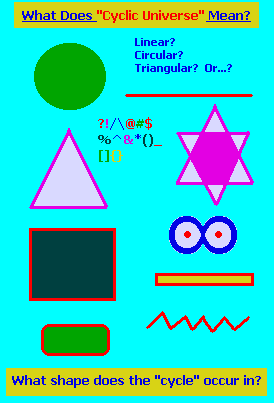
What does the word "cyclic" mean when applied to a Big Bang Universe Model? While the use of the word "cycle" (and its derivatives) influences some people into visualizing a circle-like process, it should be considered that the actual process may be more in the shape of some other geometric form such as a line, square, triangle, zig-zag, alternation (like alternating current), etc... And though most of us would agree that the "cycle" label means there is a repetition, does this necessarily mean that the repetition occurs in a circular fashion? Repetition can occur in a linear fashion, or a triangular fashion, or a star-shaped fashion. In fact, repetition could mean any number of geometric forms. Take for example the repetition of hammering nails in sheet-rock, asphalt roof tiles, etc... If our eyes could follow the many behaviors exhibited as someone is hammering, what sort of pattern would be displayed? Likewise, just because present models of the Universe illustrate an explosion that some claim should be uniform in all directions, does this necessarily imply that a circular model is accurate?

Mitotic images source:
With respect to the idea that matter should be evenly spaced from a Big Bang explosion, is surely laughable. This implies that any time a Big Bang takes place, it is a "perfect" explosion. Anyone who has ever played with toy gun paper caps, fire crackers, bottle rockets, Roman candles, M-80's (¼ stick of dynamite), blasting caps with dynamite, mortar shells, homemade bullets, grenades, etc., knows very well that the "shrapnel" is never uniform in all directions. In fact, in terms of particularly designed military explosives, there is a recurring usage of an up-and-out dispersal. For example, some soldiers report that though they experienced some hearing loss after a grenade exploded nearby, they were completely untouched by shrapnel because the force was directed up-and-outward, and not down- and-sideways while they were laying on the ground. This is not to say that some bombs are not designed to explode down-and-sideways, it's just that most explosives, like electrons in an electrical circuit, or water in a stream, always take the route of least resistance. Hence, the explosion is not uniform in all directions.
To think that each and every Big Bang is akin to some perfect explosion which ejects matter in a uniform "expression," is just as silly as was the ideas of those who expected Mount St. Helens to explode like a "perfect" volcano, meaning through the top. When it exploded out of one side, the observers were taken completely by surprise that nature hadn't respected the opinions of those who were expecting a display of a perfectly uniform out-of-the-top explosion. No less, in terms of an expanding and collapsing Universe, to think that the Universe is simply going to retrace (collapse along) the same path from where it came, as if someone played a movie, tape recorder, or song, in reverse, is rather stupid of humanity not to consider other scenarios.
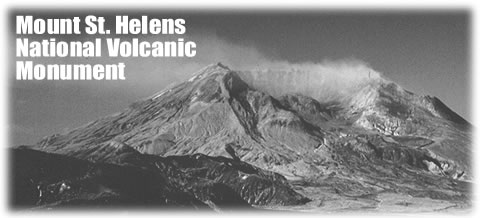
At 8:32 Sunday morning, May 18, 1980, Mount St. Helens erupted.
Shaken by an earthquake measuring 5.1 on the Richter scale, the north face of this tall symmetrical mountain collapsed in a massive rock debris avalanche. Nearly 150 square miles of forest was blown over or left dead and standing. At the same time a mushroom-shaped column of ash rose thousands of feet skyward and drifted downwind, turning day into night as dark, gray ash fell over eastern Washington and beyond. The eruption lasted 9 hours, but Mount St. Helens and the surrounding landscape were dramatically changed within moments.
At this point, here are a few questions which come to mind:
- Does a Big Bang event eventually collapse in the same direction from where it came?
- Do several Big Bang events occur at the same time?
- Do Big Bang events occur intermittently, sporadically or serendipitously?
- Does a Big Bang event take place as the result of two (or more) Universes collapsing into one another?
- Does a collapse take place in an opposite direction from where the initial Big Bang Expansion came from?
- Does or can a Big Bang explosion or Universe collapse occur in a "sideways"-like motion (such as that which occurred when Mt. Saint Helens erupted)?
- Does or can a Big Bang explosion occur by two (or more) Universes expanding into one another (like slapping one's hands together)?
- Is the expansion (collapse?) of a Universe in a fluid state, whereby two (or more) expanding Universes are like aiming the water streams of two garden hoses together which results in a "dispersal" (explosion)?
- Do collapses actually occur or is this "logical" scenario merely a part of a human brain still experiencing a polarized form of dichotomous thinking?
- Do Big Bangs (as portrayed presently by humanity) actually occur? If so, are such Big Bang collapses ever interrupted in the sense of collapsing ahead of some presumed intended time scale event?
- Do all expansions and collapses become fully "expressed," or are there a variety of models like differences in fire-crackers or dynamite due to ingredients, cellulose composition, age, etc...?
The following CONE images are just a few considerations of different scenarios related to the ideas of a Big Bang expansion and Universe collapsing (the assumed Big Crunch). Visually mix and match, flip them over, angle them, as well as distort them as you please:
 |
 |
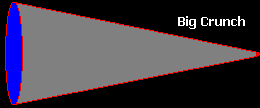 |
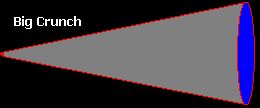 |
 |
 |
 |
 |
 |
 |
If we were to view these images from the perspective of an internal combustion engine mechanic, we might want to consider the events in the development of a Universe as a type of 3-cycle (rotary?) engine, with the conventional so-called four-stroke cycle as actually representing an overlapping 3-cycle repetition.
However, it should be noted that the arrangement of the above Universe images might give the impression of a progressively 2-step linear-like development from the Big Bang to the Big Crunch. It might be of greater value to take into consideration that the three theories of the Universe (Flat, Spherical, Saddle-shaped) maybe separate representations of the same occurrence.
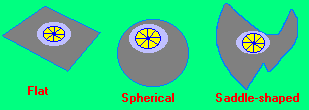
 The three different views are like three different blind individuals describing
an elephant by touching different parts such as the leg, ear, and belly. Thus,
by putting the three theories together, we come up with a linear, circular, triangular-
like configuration that reminds me of a pedestal fan.
The three different views are like three different blind individuals describing
an elephant by touching different parts such as the leg, ear, and belly. Thus,
by putting the three theories together, we come up with a linear, circular, triangular-
like configuration that reminds me of a pedestal fan.
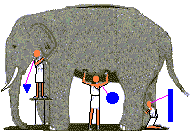
The "leg" portion of the elephant can be viewed as time's arrow or the path along which occurs the development of "a" Universe. The ear portion of the elephant can be seen as a "flickering" fan blade which is similar to the dynamic processes of the Universe's developmental movement. The rotund belly of the elephant can be likened to the circular inter-meshed wire which houses the fan blades and can be associated with the sur-rounding dark matter (and stars). The "out reaching" ground on which the elephant stands can be seen as the base of the fan and be identified with the beginning (Big Bang) and end (Big Crunch) of structural support.
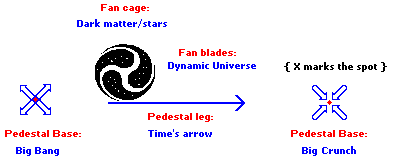
Just as the form of a pedestal fan might be said to be a symbolic representation of a cognitive impression that was initially molded by cosmological influences on a biological substrate, the myriad forms of triskelion models occurring in different time periods (as well as worded tripartite forms,) might be interpreted as abbreviated models of the same thing...

We could also imagine a representative "funnel" image of an expanding (or contracting) Universe as a type of funnel-like tornado formation caused by cold "mass" colliding with a warm/hot "mass," though in actual Earth-bound tornado formation, cold dry polar air meets/collides with warm moist tropical air. We must also note that an Earth-bound tornado funnel begins from the wide-mouth end out of a cloud and the small "pointed" end/tip touches the Earth. Observation of this event might make us wonder whether it is the Earth or the overhead clouds which acts as a sort of base.
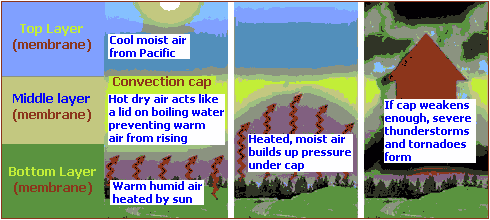
3 links for Tornado information:
--- Tornadoes ---
--- Tornado Formation ---
--- Tornado Formation ---
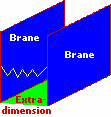
The idea that our three-dimensional universe is one of two surfaces, or "branes," separated by an extra dimension, is clearly represented in the same idea with respect to the pictures of cell membranes seen through the usage of an electron microscope:
The cell is highly organized with many functional units or organelles. Most of these units are limited by one or more membranes. To perform the function of the organelle, the membrane is specialized in that it contains specific proteins and lipid components that enable it to perform its unique roles for that cell or organelle. In essence membranes are essential for the integrity and function of the cell.
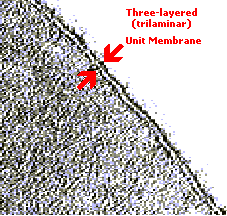
Plasma membranes, like other membranes, are complex and diverse. They can be isolated by cell disruption followed by differential centrifugation and studied by x-ray diffraction, freeze-fracture-etch, and micro-chemistry. The erythrocyte plasma membrane has been extensively studied because large amounts can be easily prepared. the plasma membrane is approximately 75 Angstroms in thickness with a range of about 60 to 90 Angstroms. As with most intracellular membranes, it is seen as a trilaminar structure, termed the unit membrane, with outer darker lines approximately 20 Angstroms wide and an inner lighter line, approximately 35 Angstroms wide. Note the trilaminar character of the plasma-lemma, there being two dark laminae separated by a light one. This membrane is a unit membrane. [magnification- X280,000].
(From the work of JD Robertson.)
...In terms of biological structures, membranes are said to have a distinct inner and outer surface, which is labeled "bifacial" in the jargon of biologists. We must wonder whether or not the "Brane" structures of the Universe are similarly structured and can thus be likewise named.
For a short overview of Membrane development history:
So what's going on here? Are physicists merely plagiarizing ideas from cellular biology and adapting them to their own work on theories of the Universe? If not by intention, then perhaps by innocently getting the vision of an impression from a biology lecture or book that they had experienced years ago, which have resurfaced into images related to their particular interests? Is humanity re-experiencing ancient ideas of the Universe being a living organism with all its galaxies, planets, comets, dark matter, etc., similar to cells, blood plasma, cellular debris, etc...?
Is humanity nothing more than some microscopic organism living off of another organism (Earth) that lives off another organism (Sun), etc..., in a sort of symbiosis? Are Universes nothing more than a type(s) of cell that grow and die while they stream through the plasma of space; occasionally colliding into one or more other cells? Is a biological model a particularly good idea for events in the Universe? Are events occurring on the actual cellular level, merely microscopic events of circumstances taking place in the Universe, and that it is not a case where the Universe replicates cellular/biological events, but that such events are miniature derivations of the Universe? If so, then the Universe may exhibit several different aspects of a variety of such microscopic structures and activities, since they exhibit mere fragments of the Universe. In other words, we will have to combine several different models from different areas in order to accurately illustrate events taking place in the Universe.
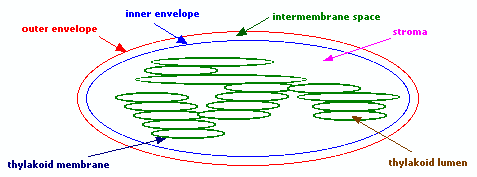
The chloroplast has three membranes:
- Inner envelope.
- Outer envelope.
- Thylakoid.
It has three compartments:
- Stroma.
- Thylakoid lumen.
- Inter-membrane space.
These compartments and the membranes that separate them serve to isolate different reactions of photosynthesis: Dark reactions take place in the stroma and light reactions take place on the Thylakoid membrane.
(What? No intermediate "grey area" reactions in plants?)
While there are many people who have not seen a trilaminar cell membrane structure, nor the three membranes in plant chloroplasts, they have seen triple layered items such as sandwiches, ice cream cones, electrical wiring, street lights, flag colors, 3-piece suits, triple wedding rings, etc...
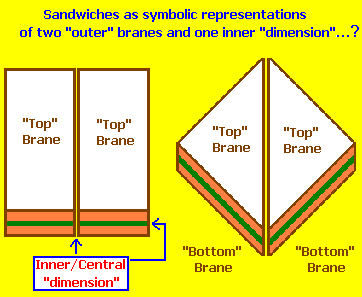
 Movie Maniac's |
 | ||
| Traditional 3-layered Universe "cone." | Multi-dimension Universe, cellular division, Big Bang, or... | The 3 layered Universe spinning and collapsing/expanding from a "triangular cone." | A mathematician's eyes (on multiple dimensions) are sometimes bigger than their stomach. |
We might want to look around us and identify other constructs that represent a three-part structure:
- Tennis court sides with a net as a membrane- circular ball with "membrane" racquets.
- Badminton court sides with a net as a membrane- triangular shuttlecock (birdie) with "membrane" racquets.
- Volleyball court sides with a net as a membrane- circular ball.
- Tetherball "court" sides with lines as a membrane- circular ball with string.
- Bowling alley (sides used in tournament play), foul line as a membrane- circular ball and triangular pins in a triangular setup.
- Basketball court sides with nets and lines as membranes- circular ball.
- Football field sides with lines as membranes- triangular/hourglass/diamond ball.
- Soccer field sides with lines and netted goals as membranes- circular ball.
- Baseball field (diamond) with batting/fielding exchanges as one type of membrane- linear bat, circular ball, triangular (fully opened) gloves. Other "membranes" are center field wall, individual/team records, etc...
- The subtle "membranes" called procedures used in a "court" room.
- The "the line" between genius and madness can be called a thin membrane.
- The so-called "veneer" said to exist with different social groups is a type of layering.
- etc...
We could also add such three-part "structural events" as:
- Breaking the sound barrier- person and machine on one side, with the barrier as a membrane to cross over to the "other side."
- Breaking a sports record -membrane is record.
- Accomplishing a goal.
- Trying to contact a dead loved one on "the other side." (seances, Ouija boards, tarot cards, etc...)
- Presumed racial barriers.
- Presumed financial barriers.
- Presumed educational barriers.
- Presumed lack of talent barriers.
- The "Zone" membrane/barrier spoken of in sports, dieting, consciousness, etc.
- Pushing the "envelope" in terms of exceeding one's conventional or trained abilities, actions, intentions, etc...
- Catching one's "2nd wind" for extended periods of physical/mental/emotional exertion.
- etc...
Does the existence of thinking in terms of "barriers" (membranes) and the crossing of a barrier (for instance, in inter-ethnic marriages), which may result in various types of explosive social/family/friend consequences, influence the thinking of those who are designing theories, or are such human-centered social "membranes" just another symbolic reflection of events taking place in the larger Cosmos?
And when considering barriers as membranes along with a relationship to "cones", one may well think in terms of a sonic boom related to the transgression of an aircraft at or beyond the sound "barrier":
(A Sonic Boom is a) shock wave that is produced by an aircraft or other object flying at a speed equal to or exceeding the speed of sound and that is heard on the ground as a sound like a clap of thunder.
When an aircraft travels at subsonic speed, the pressure disturbances, or sounds, that it generates extend in all directions. Because this disturbance is transmitted earthward continuously to every point along the path, there are no sharp disturbances or changes of pressure. At supersonic speeds, however, the pressure field is confined to a region extending mostly to the rear and extending from the craft in a restricted widening cone (called a Mach cone). As the aircraft proceeds, the trailing parabolic edge of that cone of disturbance intercepts the Earth, producing on Earth a sound of a sharp bang or boom. When such an aircraft flies at a low altitude, the shock wave may be of sufficient intensity to cause glass breakage and other damage. The intensity of the sonic boom is determined not only by the distance between the craft and the ground but also by the size and shape of the aircraft, the types of maneuvers that it makes, and the atmospheric pressure, temperature, and winds. If the aircraft is especially long, double sonic booms might be detected, one emanating from the leading edge of the plane and one from the trailing edge.
Source: "sonic boom." Encyclopædia Britannica Ultimate Reference Suite, 2013.
Another analogy to the 3-membrane cyclic universe model can be found in the early model of a common battery design. The first battery, as developed by Alessandro Volta in 1800 consisted of alternating layers of (1) zinc, (2) blotting paper soaked in salt water and (3) silver. This arrangement was known as a "voltaic pile," which I have turned sideways for the purposes at hand. The top and bottom layers (left and right sides) of the pile must be different metals, as shown. If you attach a wire to the top and bottom of the pile, you can measure a voltage and a current from the pile. The pile can be stacked as high (or as long) as you like, and each layer will increase the voltage by a fixed amount:
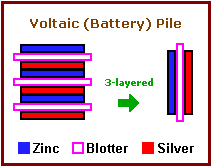
--- How Stuff Works- How Batteries Work ---
While Volta is given credit for the first battery, there is evidence for an earlier usage uncovered by Archaeologists. Ancient battery-like cells have been discovered in Sumerian ruins, originating around 250 BC:

The first evidence of batteries comes from archaeological digs in Baghdad, Iraq. This first "battery" was dated to around 250 B.C. and was used in simple operations to electro-plate objects with a thin layer of metal, much like the process used now to plate inexpensive gold and silver jewelry, which is considered to be one of the first uses for batteries. The first 'battery' was found in Khujut Rabu just outside Baghdad and is composed of a clay jar with a stopper made of asphalt. Sticking through the asphalt is an iron rod surrounded by a copper cylinder. When filled with vinegar - or any other electrolytic solution - the jar produces about 1.1 volts.
Page initially created (approx.): Friday, 10th May 2013, 6:30: AM
Page updated: Tuesday, 29th-May-2018... 12:40 PM
Newest update: Tuesday, 30th March, 2021... 1:25 PM
Herb O. Buckland
herbobuckland@hotmail.com